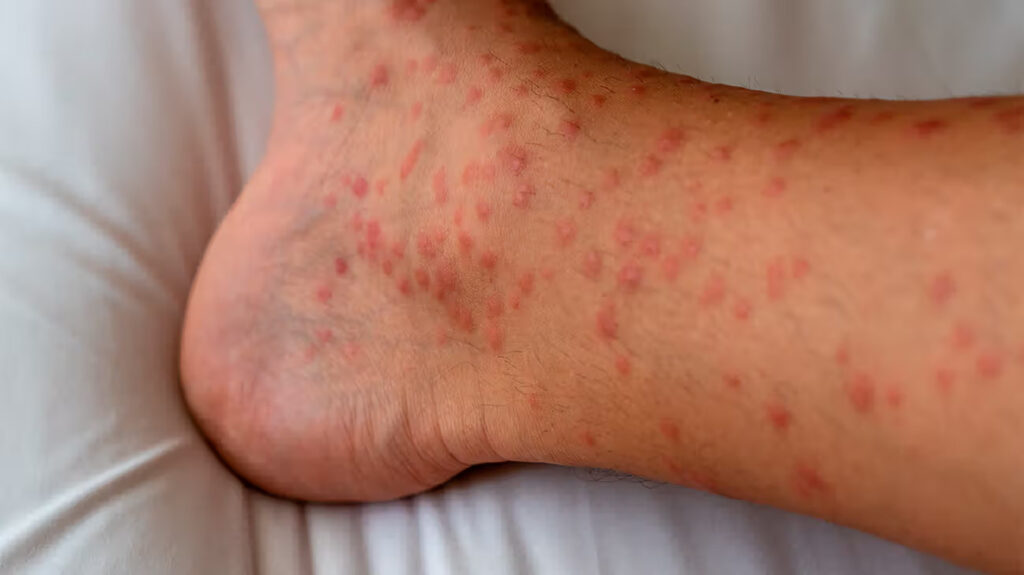Papular dermatitis (papular eczema) is a skin condition characterized by small, raised bumps on the skin that can be itchy and uncomfortable. This comprehensive guide will explore the causes, symptoms, diagnosis, and treatment options for papular dermatitis, helping you better understand and manage this common skin issue.
What is Papular Dermatitis?
Papular eczema is a type of inflammatory skin condition that manifests as small, raised bumps (papules) on the skin’s surface. These bumps are often red, itchy, and can appear in clusters or spread across larger areas of the body. While it can affect people of all ages, papular eczema is particularly common in children and young adults.
Key Facts About Papular Dermatitis:
- It’s a form of eczema or dermatitis
- Characterized by small, raised bumps (papules) on the skin
- Often itchy and can cause discomfort
- Can occur on various parts of the body
- May be acute (short-term) or chronic (long-term)
Causes of Papular Dermatitis
The exact cause of papular dermatitis isn’t always clear, but several factors can contribute to its development:
- Allergic Reactions: Contact with allergens such as certain fabrics, metals, or plants can trigger papular eczema in some individuals.
- Environmental Factors: Exposure to extreme temperatures, humidity, or dry conditions can irritate the skin and lead to papular eczema.
- Genetic Predisposition: Some people may be more susceptible to developing papular eczema due to their genetic makeup.
- Immune System Dysfunction: An overactive immune response can sometimes lead to inflammation in the skin, resulting in papular eczema.
- Skin Barrier Issues: A compromised skin barrier function can make the skin more vulnerable to irritants and allergens, potentially leading to papular eczema.
Symptoms of Papular Dermatitis
Recognizing the symptoms of papular dermatitis is crucial for early diagnosis and treatment. Common signs include:
- Small, raised bumps (papules) on the skin
- Redness around the affected areas
- Intense itching (pruritus)
- Dry or scaly skin
- Possible skin thickening in chronic cases
- Clusters of bumps that may merge into larger patches
- Discomfort or pain in severe cases
It’s important to note that symptoms can vary from person to person and may change over time. Some individuals may experience periodic flare-ups, while others may have more persistent symptoms.
Diagnosis of Papular Dermatitis
Diagnosing papular dermatitis typically involves a combination of visual examination and medical history review. A dermatologist or healthcare provider will:
- Examine the affected skin areas
- Ask about symptoms, their duration, and any potential triggers
- Inquire about family history of skin conditions
- Possibly perform a skin biopsy in unclear cases
- Consider patch testing if an allergic cause is suspected
Differential diagnosis is important, as papular eczema can sometimes be confused with other skin conditions such as:
- Atopic dermatitis
- Contact dermatitis
- Folliculitis
- Keratosis pilaris
- Lichen planus
Treatment Options for Papular Dermatitis
Managing papular dermatitis often requires a multi-faceted approach. Treatment options may include:
1. Topical Medications
- Corticosteroid creams or ointments: These can help reduce inflammation and itching.
- Calcineurin inhibitors: Medications like tacrolimus or pimecrolimus can help modulate the immune response in the skin.
- Antihistamine creams: These can provide relief from itching in some cases.
2. Oral Medications
- Antihistamines: Oral antihistamines can help control itching, especially at night.
- Antibiotics: If a secondary bacterial infection is present, antibiotics may be prescribed.
- Oral corticosteroids: In severe cases, short courses of oral steroids might be recommended.
3. Light Therapy
Phototherapy, particularly narrow-band UVB treatment, can be effective for some cases of papular dermatitis.
4. Lifestyle Changes and Home Remedies
- Moisturizing: Regular use of emollients can help maintain skin hydration.
- Avoiding triggers: Identifying and avoiding known allergens or irritants is crucial.
- Cool compresses: These can provide relief from itching and inflammation.
- Gentle skincare routine: Using mild, fragrance-free cream can help prevent irritation.
Prevention Strategies for Papular Dermatitis
While it may not always be possible to prevent papular dermatitis, certain strategies can help reduce the risk of flare-ups:
- Maintain good skin hygiene: Regular, gentle cleansing can help keep the skin healthy.
- Use moisturizers: Keeping the skin well-hydrated can strengthen the skin barrier.
- Identify and avoid triggers: Pay attention to what might be causing flare-ups and try to avoid these factors.
- Manage stress: Stress can exacerbate skin conditions, so finding effective stress management techniques is important.
- Wear breathable fabrics: Choose clothing made from natural, breathable materials to reduce skin irritation.
- Control your environment: Use a humidifier in dry conditions and avoid extreme temperature changes when possible.
Living with Papular Dermatitis
Coping with papular dermatitis can be challenging, but with proper management, most people can effectively control their symptoms. Here are some tips for living with papular eczema:
- Follow your treatment plan: Consistency is key in managing papular eczema.
- Join support groups: Connecting with others who have similar experiences can provide emotional support.
- Educate yourself: Stay informed about your condition and new treatment options.
- Communicate with your healthcare provider: Regular check-ups and open communication can help optimize your treatment.
- Practice self-care: Engage in activities that promote overall health and well-being.
When to See a Doctor
While mild cases of papular dermatitis can often be managed at home, it’s important to consult a healthcare provider if:
- Symptoms are severe or worsening
- The condition is affecting your quality of life
- You suspect a skin infection
- Home treatments aren’t providing relief
- You’re unsure about the diagnosis
Conclusion
Papular dermatitis is a common skin condition that, while often uncomfortable, can be effectively managed with proper care and treatment. By understanding its causes, recognizing its symptoms, and exploring various treatment options, individuals affected by papular eczema can take control of their skin health. Remember, each case is unique, so working closely with a healthcare provider to develop a personalized management plan is crucial for achieving the best possible outcomes.
If you’re experiencing symptoms of papular eczema or have concerns about your skin health, don’t hesitate to seek professional medical advice. With the right approach, you can minimize discomfort, prevent flare-ups, and maintain healthy, comfortable skin.
To read more articles click here.



